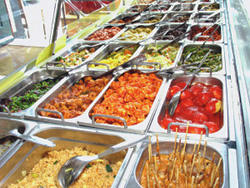
Do they sell software that generates interesting titles for blog entries without you having to be involved?
Posting frequency has fallen off around here because I overcooked myself in May and June. Cooked out is what I am. So I've mostly been eating extremely simply, broiled fish or gyoza 60% of the time. Oh I know what else we were eating the other 40% of the time: sandwiches. Indonesian sandwiches. Primarily fish. Let me explain, hurriedly and with little regard for the creative turn of phrase (I'll revise later).
+++
What I would ideally do here is investigate the evolution of immigrant cooking here in The Netherlands, specifically the cuisines of the former colonies, Indonesia and Suriname. As far as I can tell there's no page on the web that explains this in English. Here's a Dutch version, and here's a more professionally researched version that focuses more specifically on the Chinese side of things. Until I have time to write something with more detail, I'll try to summarize via a massive simplification (i just watched Adaptation again yesterday and am currently imagining myself compressing eons of history into mere seconds worth of typing).
Let's start with Indonesia: after the second World War, Indonesia was granted its independence from Holland after having been a Dutch colony since the 17th century. 250,000 Indonesians came to Holland to repatriate themselves. Well, rewind a bit: by this point the Dutch were already vaguely familiar with Asian cuisine because, around 1918, small Chinese communities began to emerge in the port cities of Rotterdam and Amsterdam, mostly stokers who worked on the large steam ships of that time.
This population got a boost after 1919, when Great Britain amended the Aliens Restriction Act of 1914, and Chinese seamen were no longer entirely welcome on British soil, so they ended up in Dutch ports (their numbers growing to almost 3000 Chinese before shrinking again during the Second World War). Eventually Chinese teahouses and restaurants emerged, thus introducing the Dutch to the first truly foreign cuisine they'd encountered on their own soil.
So, back to the 250,000 Indonesians (some of whom were Indonesian Chinese, to further confuse the issue). Well, the Dutch Indonesians came, brought their culinary culture with them, and eventually opened up restaurants and shops. It didn't hurt that thousands of Dutch soldiers had been stationed in Indonesia and grew very fond of the food there. The returning Dutch soliders took their friends and families to eat at these restaurants. This happened so long ago, and so early on in the evolution of "eating out" in Holland, that by 2005 Indonesian food is not even really considered foreign here.
The point of all this is that, as in many ex-colonial relationships, the Dutchified Indonesian kitchen has evolved to accommodate some long-standing preferences of the Nederbelly. Some of these adaptations are to be expected (bigger portions, fewer chiles), but some are a bit unusual (Belgian frites with Indonesian peanut sauce and mayonnaise is a popular way to eat fries...not really so unusual in concept--think gado gado--but it's surprising at first to see people carrying cones of fries with an unrecognizable brown goo on them).
Which at last, almost brings me to Indonesian-Surinamese sandwiches. In Java or Bali the common accompaniements to fish, meat, and soy dishes are either nasi or bami (rice or noodles), right? Well, sandwich culture has had significant mindshare here for a long long time (I'll explain the boterham in another post). And so, one of the ways you can eat your Indo-Chinese fish/meat/veg dish is on a sandwich instead of with rice or noodles.
OK. Part 2 to follow (maybe). You know, the part where I maybe actually talk about the sandwiches.
+++

No comments:
Post a Comment